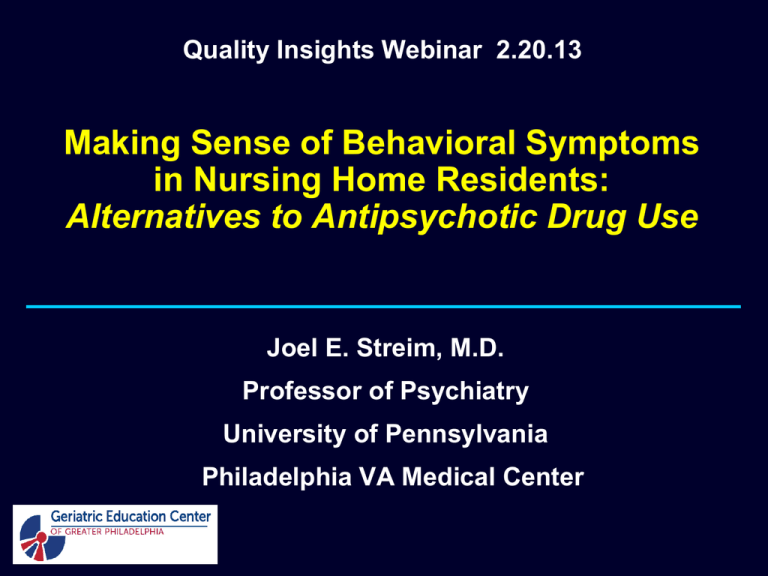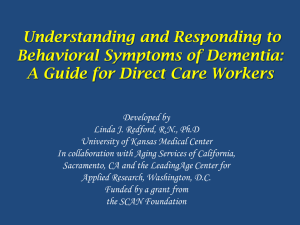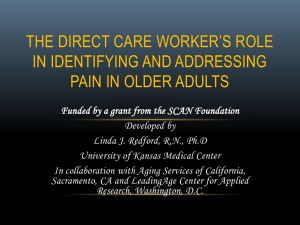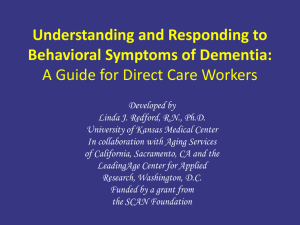Making Sense of Behavioral Symptoms in Nursing Home Residents
advertisement

Quality Insights Webinar 2.20.13 Making Sense of Behavioral Symptoms in Nursing Home Residents: Alternatives to Antipsychotic Drug Use Joel E. Streim, M.D. Professor of Psychiatry University of Pennsylvania Philadelphia VA Medical Center Disclosures Dr. Streim is on the faculty of the Geriatric Education Center of Greater Philadelphia, which is funded by the Bureau of Health Professions, Health Resources and Services Administration (HRSA), Dept. of Health and Human Services (DHHS). The content of this presentation is solely the responsibility of the presenters and does not necessarily represent the official views or policies of HRSA or the DHHS. Objectives 1. Explain challenging behaviors among nursing home residents by recognizing common causal or contributing factors. 2. Identify non-pharmacological interventions that are likely to produce desired results in modifying behavior. 3. Give examples of the systemic barriers to implementing non-pharmacological interventions in nursing facilities Overview Three premises lead to the conclusion that: 1 Antipsychotic drug treatment is usually not the most appropriate response to most resident behaviors; and 2 Sensible, effective, non-pharmacological responses to behavior required a patientcentered approach to care. Premise #1 Not all behavioral symptoms are problems A behavior becomes a problem when it is associated with: — Distress (subjective experience of the resident) — Disability (observable functional impairment) — Disruption (interference with delivery of care, or disturbance of the living environment) — Danger (to self or others) Premise #2 Most problematic behaviors among nursing home residents are not likely to respond to antipsychotic drugs Most behaviors are not caused by psychotic illnesses. Only a small proportion of residents have conditions that can be appropriately treated with antipsychotic medication, such as: • Schizophrenia • Bipolar disorder • Depression with psychosis • Dementia with psychosis, in selected cases Premise #3 Behavior problems are commonly triggered by an approach to care that fails to incorporate the resident’s own experience Care that is based solely on facility routines and caregivers’perceptions often causes the resident to become anxious, fearful, irritable, or angry. Resultant behaviors may include — Restlessness — Yelling or verbal hostility — Rejection of care — Physical combativeness Case Example A very confused 83-yr-old female resident, Mrs. M, sees staff put on coats and get ready to leave at change of shift (3pm). Resident heads to the exit door. A CNA runs after her, yelling “no, you can’t go out there.” Resident pushes the CNA away. Note entered in chart says “resident tried to elope, and was physically aggressive toward staff.” Attending physician is called and gives an order for haloperidol 2 mg every day. Alternative Patient-centered Approach When patient heads to exit door, CNA asks: “Can I help you?” Resident says, “I have to go home to get a snack ready for my daughter. She’ll be home from school any minute.” CNA says, “OK, I’ll help. Let’s go to the kitchen and get some cookies for your daughter. I bet she’ll like them. What’s her name?” The resident turns away from the exit door, and follows the CNA to the kitchen area. What do we need to learn as caregivers? How to make sense of behavioral changes associated with dementia and other conditions — 1. Understand and empathize with the resident’s experience — 2. Recognize factors that cause or contribute to behavioral problems Once understood, interventions and management strategies become apparent Assessment informs approach to care Making Sense of Resident Behavior All behavior makes sense / has meaning Applies to residents with and without dementia Looking for reasons behind behaviors by “stepping into the resident’s world” enables us to identify person-centered solutions that — Are responsive to resident needs — Avoid using unnecessary medications Person-centered Care: WHY? Key to culture change in nursing homes Resident and staff become part of a caregiver / care-recipient partnership Increases residents’ perception that staff is “on their side” — Residents become less likely to experience care as adversarial — Staff becomes less likely to experience caregiving as a struggle Person-centered Care: WHAT? Focus on the resident’s experience — Try to imagine being in their world — Consider how things look from their perspective Accept their reality — Their subjective experience is real to them — Doesn’t mean you actually adopt their point of view for yourself Person-centered Care: HOW? Look for meaning in verbal and non-verbal communication Ask, “what do you want? “how can I help?” Listen for clues to sources of distress or unmet needs Avoid saying “no”, arguing or disagreeing Offer to help in ways that reduce distress or meet needs, without compromising safety Making Sense of Behaviors A richer understanding of the resident’s experience also requires the identification of causal and contributing factors Causal and Contributing Factors Behavioral symptoms can be multiply determined by — Cognitive deficits — Unmet needs (physical and psychological) — Environmental / social irritants — Medical illness / physical discomfort — Psychiatric conditions — Adverse drug effects Cognitive Domains Impaired in Dementia Memory loss (amnesia) Decline in other cognitive functions — Language (aphasia) — Visual-spatial function — Recognition (agnosia) — Performing motor activities (apraxia) — Initiating/executing sequential tasks (apathy, abulia, executive dysfunction) How does memory impairment lead to behavioral problems? Example Patient can’t remember where his clothes are kept Walks into hallway naked How does language impairment (aphasia) lead to behavioral problems? Example Patient who can’t verbally communicate that pills are hard to swallow Spits medication at caregiver How does impaired visual recognition (agnosia) lead to behavioral problems? Example Patient can’t recognize a spoon as a utensil for eating Throws the spoon on the floor How does impairment in performance of motor tasks (apraxia) lead to behavioral problems? Example Patient cannot manipulate zippers or buttons to unzip or unbutton his pants Wets his clothing Common misattributions for behaviors Caregiver may assume resident is: Angry / Belligerent Lazy / Dependent Manipulative Often, a behavior that is interpreted as “uncooperative” is actually better explained by cognitive disability Emphasize Resident Strengths Recognize areas of impaired function and areas of preserved function Help compensate for impairment Support and celebrate residual abilities — Focus on something unique that person feels good about — Express appreciation and admiration Remember: There’s no one-size-fitsall response to behaviors Different residents have different situations and needs Residents change over time; needs and behaviors change, too Some responses work one day, not the next Some responses work for one caregiver, but not another Responses must be tailored to the individual and modified over time Strategies for Communicating with Residents with Language Comprehension Deficits Sit down; communicate at eye-level Connect with smiles, humor Reassure with simple words, comfort with touch Use visual and gestural cues Speak slowly, using short sentences, single words — One idea, one direction at at time — Be patient; give adequate time to process and respond Avoid using negative tone or words — Don’t scold or argue When language comprehension is severely impaired, use other senses to communicate — Smell, touch, vision, taste What modifiable factors may contribute to behavioral changes in nursing home residents (with or without dementia)? Unmet needs that can lead to behavioral disturbances All residents—whether cognitively intact or impaired—have common, basic needs Physical needs — Nutrition, hydration, toileting, exercise, rest Psychological needs —Security, autonomy, affection, self-worth Environmental irritants that can lead to behavioral disturbances Physical — Noise — Confusing visual stimuli — Physical barriers — Uncomfortable temperature — Unfamiliar surroundings Social — Changes in routines — Caregiver interactions Medical conditions and physical discomfort that can lead to behavioral disturbances Medical condition Physical discomfort — Arthritis — Pain — Dehydration — Constipation — Prostatic hypertrophy — Urinary urgency — COPD — Shortness of breath — Cerebrovascular disease — Dizziness — CHF — Fatigue Psychiatric conditions that can cause behavioral disturbances Depression Delirium Psychosis — delusions — hallucinations Anxiety Sleep disturbance Adverse drug effects that can cause behavioral disturbances Nuisance symptoms Anticholinergic effects Antihistaminic effects Paradoxical excitation / disinhibition Intoxication or withdrawal states Akathisia (syndrome of motor restlessness) Identification of any of these modifiable causes— unmet needs environmental and social irritants medical illness and physical discomfort psychiatric conditions adverse drug effects— points the way to specific interventions Institutional resources to promote non-pharmacological approaches Consistent staff assignments Assignment of staff across disciplines to supervise everyday leisure activities — Group — Individual / solitary — Beyond structured recreation therapy Space for exercise, outdoor activities Barriers to Implementation of Nonpharmacological Approaches Ingrained culture of medical and nursing care Inadequate staff training Staff turnover Aversion to risk-taking — Need to accept that risks are part of normal, everyday life — Need to change attitudes of families, staff, administrators, regulators, surveyors, legal counsel Resources for Training and Implementation CMS campaign website: http://www.nhqualitycampaign.org/star_index .aspx?controls=dementiaCare Hand-in-Hand (person-centered dementia care training materials): http://www.cmshandinhandtoolkit.info/Index.aspx Questions & Discussion








